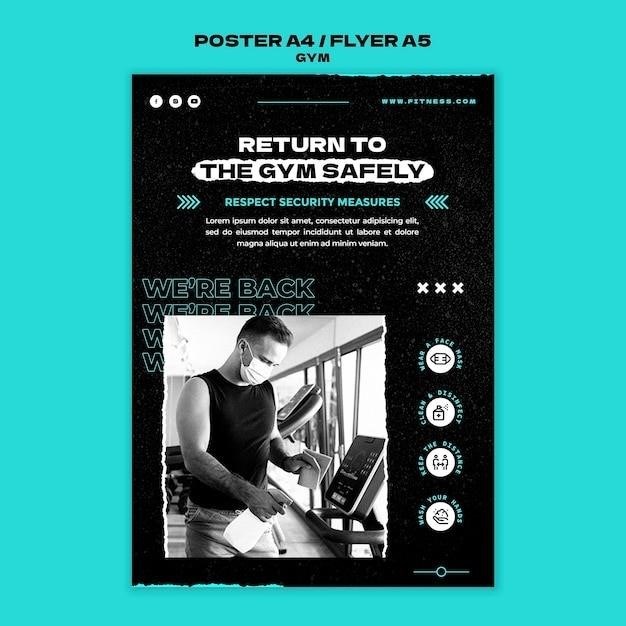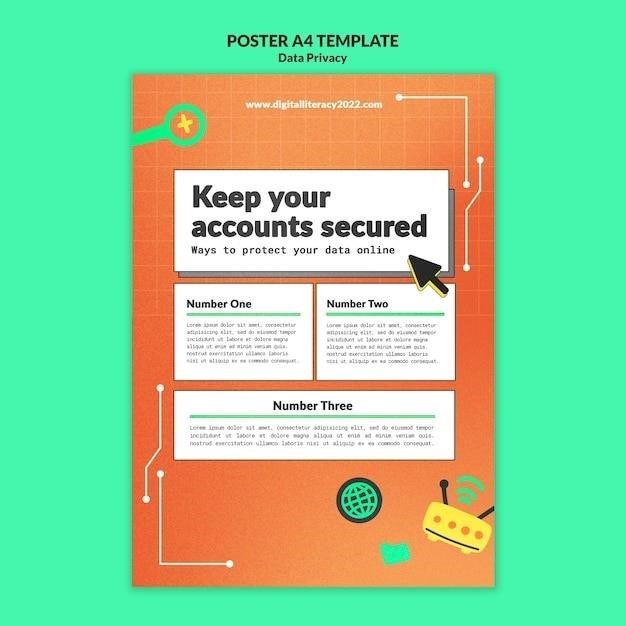
Sharper Image Drone Instruction Manual⁚ A Comprehensive Guide
This manual provides a complete guide to operating your Sharper Image drone. It covers pre-flight checks, charging procedures, pairing instructions, control explanations, basic and advanced flight maneuvers, troubleshooting, maintenance, and customer support contact information. Ensure safe and enjoyable drone operation.
Pre-Flight Checklist and Safety Precautions
Before each flight, meticulously review this checklist for safe operation. Begin by carefully reading all warnings and instructions included in this manual and any accompanying documentation. Ensure the drone’s battery is adequately charged; refer to the charging instructions for details. Install fresh batteries in the remote control, confirming proper polarity. Inspect the drone’s propellers for damage or wear; replace any damaged components. Choose a spacious, open area free from obstacles, power lines, and people. Check local regulations and airspace restrictions before initiating flight. Confirm the drone’s GPS signal is strong and stable for optimal performance and safe return. Always maintain visual contact with the drone during flight. Avoid flying in adverse weather conditions such as strong winds, rain, or fog. If you are a beginner, practice in a safe, controlled environment before attempting more advanced maneuvers. Remember, responsible operation is crucial for a safe and enjoyable flying experience. Report any issues to Sharper Image customer support.

Charging the Drone and Remote Control Batteries
Charging your Sharper Image drone and remote control batteries correctly is paramount for optimal performance and safety. The drone battery typically uses a lithium-polymer (LiPo) battery; these require specific charging procedures. Never leave LiPo batteries unattended while charging. Use only the provided charger; using an incompatible charger may damage the battery or cause a fire. Connect the drone battery to the charger according to the instructions provided. The charging time varies depending on the battery’s capacity; consult your specific model’s manual for details. A fully charged battery will usually indicate its status via LED lights. The remote control uses standard batteries; refer to the manual to check battery type and size. Install batteries correctly, paying attention to polarity. Incorrect installation may damage the remote or batteries. Do not overcharge the batteries; doing so can lead to reduced lifespan or safety hazards. Always store batteries in a cool, dry place when not in use. Dispose of used batteries properly according to local regulations. Always refer to the specific charging instructions included with your model for precise details and safety precautions.
Pairing the Drone with the Remote Control
Before your first flight, ensure your Sharper Image drone and remote control are properly paired. This process establishes a secure communication link necessary for controlling the drone. Begin by powering on the drone; typically, this involves a switch or button located on the drone’s body. Then, turn on the remote control; this usually involves installing batteries and activating a power switch. The exact steps may vary based on the specific drone model. Consult the manual for your model for detailed instructions. Many Sharper Image drones use a simple binding process. This often involves simultaneously pressing specific buttons on both the drone and the remote. The drone and remote will usually indicate successful pairing with LED lights or audible beeps. If pairing is unsuccessful, try again, ensuring both devices are within a close proximity. If problems persist, consult the troubleshooting section of your manual. Some models might require a specific sequence of button presses. Always ensure that the drone and remote are sufficiently charged before attempting pairing. Failure to properly pair the drone and remote will prevent any control of the drone.
Understanding the Drone’s Controls and Flight Modes
Familiarize yourself with your Sharper Image drone’s controls and flight modes before attempting any flights. Most Sharper Image drones utilize a standard control scheme, with joysticks on the remote for controlling direction and altitude. One joystick typically controls the drone’s pitch and roll (forward/backward and left/right movement), while the other manages yaw (rotation) and throttle (ascent/descent). Your drone might offer various flight modes to adjust its responsiveness and stability. These modes may include Beginner Mode, limiting speed and maneuverability for novice pilots, and Expert Mode, which unlocks full control for experienced users. Some models incorporate features like headless mode. This simplifies piloting by making the drone’s controls relative to the pilot’s perspective, rather than its orientation. Understanding these modes is vital for safe and controlled flights. Refer to the specific instructions included in your drone’s manual. The manual usually includes diagrams illustrating each control and its function. Pay close attention to any safety warnings or limitations. Practice in a safe, open area before tackling more complex maneuvers.
Operating Instructions⁚ Takeoff, Landing, and Basic Maneuvers
To initiate takeoff, ensure your Sharper Image drone is in a safe, open area free from obstacles and interference. Power on both the drone and the remote control, confirming a successful pairing. Many models utilize a one-button takeoff feature, simplifying the process. Alternatively, gently increase the throttle, gradually lifting the drone from the ground. Maintain a steady ascent, avoiding abrupt movements. For landing, reverse the process, gradually reducing the throttle until the drone gently touches down. Avoid sudden descents, as this could damage the drone or its components. Basic maneuvers include moving forward, backward, left, and right, achieved by using the directional controls on your remote. Practice these maneuvers in a controlled environment to build confidence and coordination. Start with slow, deliberate movements, progressively increasing speed and complexity as your skills improve. Always prioritize safety and ensure you have sufficient space for maneuvering. Consult your drone’s manual for specific instructions and safety guidelines pertaining to your model. Remember that practice and familiarization are key to mastering basic drone control.
Troubleshooting Common Drone Issues
If your Sharper Image drone fails to lift off, first check battery levels on both the drone and the remote control. Insufficient charge is a frequent cause of launch failure. Ensure proper pairing between the drone and the remote; re-pairing may be necessary after a hard landing or power interruption. If the drone drifts or flies erratically, recalibration might be required. Consult your user manual for specific recalibration instructions; this often involves adjusting control trims. Another common issue is loss of connection between the drone and the remote control; ensure sufficient distance and minimal interference. Obstacles, such as buildings or other electronic devices, can disrupt the signal. If the drone’s camera malfunctions, check the camera settings in the smartphone app (if applicable) and ensure the lens is clean and free from obstructions. For persistent problems, review your drone’s manual to determine if there are specific troubleshooting steps outlined for your particular model. If issues persist despite following troubleshooting steps, contact Sharper Image customer support for assistance. Remember to provide details of the problem, including your drone’s model number and a description of the events leading up to the malfunction. They can offer more specific guidance or arrange for repairs or replacements.
Advanced Features and Smartphone App Integration
Many Sharper Image drones offer advanced features accessible through a dedicated smartphone app. These apps typically provide enhanced control options beyond the basic remote, allowing for precise adjustments to flight parameters. Features like adjustable camera angles, real-time video streaming, and various flight modes (e.g., follow-me, waypoint navigation) are frequently included. Some apps offer the ability to take photos and record videos directly from the drone’s camera. The app might also include features for customizing settings, such as adjusting video resolution and frame rate. Before using app features, ensure your drone and smartphone are properly connected via Wi-Fi, following the instructions detailed in the manual. Note that the range of your drone’s connection to your smartphone might be limited, so operation within a reasonable distance is advised. The specific features and capabilities of your app will vary depending on the model of your Sharper Image drone. Regularly check for app updates to ensure you have access to the latest features and performance improvements. The app can also provide access to tutorials and support materials, making it a valuable resource for learning advanced drone operation techniques. Consult the app’s help section or user guide for a comprehensive understanding of its functionality. Properly utilizing the app’s features enhances your overall drone experience and enables more creative and dynamic flight possibilities.
Maintaining Your Sharper Image Drone
Proper maintenance ensures your Sharper Image drone’s longevity and optimal performance. After each flight, inspect the drone for any physical damage, such as bent propellers or loose components. Gently clean the drone body using a soft, dry cloth to remove dirt and debris. Avoid using harsh chemicals or abrasive materials. Regularly inspect and clean the drone’s propellers, ensuring they are securely attached and free from damage. Replace worn or damaged propellers promptly. Store the drone in a cool, dry place, away from direct sunlight and extreme temperatures. Keep the drone’s battery charged to an appropriate level; avoid completely depleting or overcharging the battery. Refer to the battery charging instructions in this manual for details on proper charging procedures. Always follow the manufacturer’s recommendations for battery storage and handling to maintain battery health and prevent potential safety hazards. Periodically check the drone’s connections and ensure all components are securely fastened. If you encounter any issues or require repairs, consult the troubleshooting section of this manual or contact Sharper Image customer support. Preventative maintenance, including regular cleaning and inspection, will significantly extend the operational life of your drone and ensure its continued reliable performance. Adhering to these maintenance guidelines will help preserve your investment and maximize your enjoyment of your Sharper Image drone.
Contacting Sharper Image Customer Support
Should you encounter any difficulties operating your Sharper Image drone or require assistance beyond the scope of this instruction manual, Sharper Image provides comprehensive customer support channels to address your inquiries. For immediate assistance with technical issues, questions regarding product features, or troubleshooting guidance, you can contact Sharper Image’s customer service department via phone at 1 (877) 210-3449. Their dedicated team of support representatives is available to provide prompt and helpful solutions to a wide range of issues, including problems with drone operation, battery charging, connectivity issues, or any other concerns you may have. Alternatively, you can submit your questions or concerns via email, utilizing the contact information provided on the Sharper Image website. This allows you to describe your problem in detail and receive a comprehensive response at your convenience. For less urgent inquiries, you can find answers to frequently asked questions (FAQs) on the Sharper Image website’s support section. This comprehensive resource provides solutions to many common issues, potentially resolving your problem quickly and efficiently without needing to contact customer service directly. Remember to have your drone’s model number readily available when contacting support, as this will expedite the troubleshooting process and ensure you receive the most accurate and relevant assistance. Sharper Image is committed to providing exceptional customer service and ensuring a positive experience for all its customers.



























